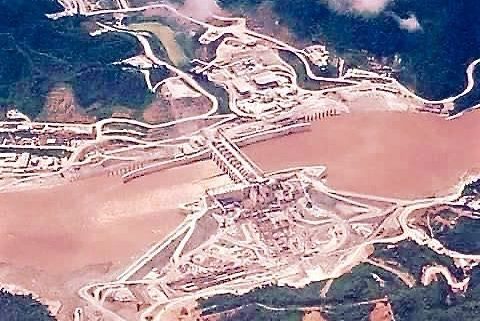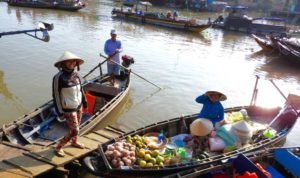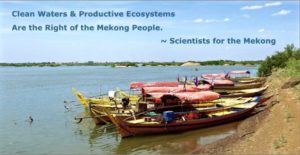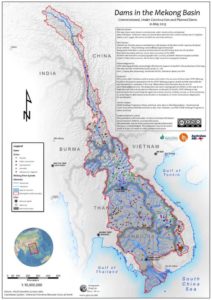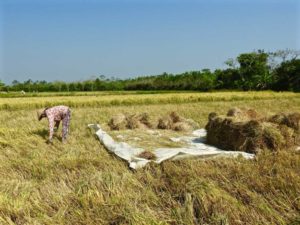Comments On: Final Report – Study on the Impacts of Mainstream Hydropower on the Mekong River and The Ripple Effect of Oxfam’s input
Comments on the Final Report of the MDS-IAR and
The ‘Ripple Effect’ of Oxfam Australia’s input
Dr. Lilliana Corredor – on behalf of Scientists for the Mekong
May 8, 2016
Download PDF of this article here:
Comments on Final Report MDS Study & Ripple Effect Oxfam
Scientists for the Mekong offers SE Asian Decision Makers, Scientists, Fisheries Experts, International Aid Organisations, NGOs and the public, the opportunity to peruse the FINAL REPORT of the latest study on the Impacts of the cascade of 11 planned Hydropower Dams in the Mekong River – on the Cambodian Tonle Sap Lake & Wetlands, and on the Mekong River Delta in Vietnam.
This much awaited 30-months study, also known as the Mekong Delta Study-Impact Assessment Report (MDS-IAR) was completed in December 2015 and published early January 2016. It was commissioned by the Ministry of Natural Resources and Environment, Vietnam – and prepared by two consultant companies DHI & HDR. This study received some financial support from Australia’s DFAT.
Download the PDF documents (3 parts), by clicking below:
(Note this is a 800 page report and the PDF files are very large)
- MDS Final Project Report 18Jan16.pdf (7.1mb)
- MDS-IAR_Vol_I-Final-Models, Models, Setup & Simulations 18Jan16.pdf (22.7mb)
- MDS-IAR_Vol 2 Final-Impact Assessment Methods & Results 18Jan16.pdf (87mb)
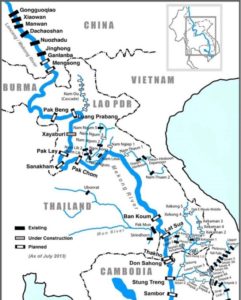
MAP-Existing & planned-Dams-Mekong-via Save-the-Mekong.org-Nov 2015
In this article we present:
1) A brief discussion of the ‘Ripple Effect’ of Oxfam Australia’s intervention and unethical conduct regarding the MDS-IAR Study. That is, we examine the actions taken by Oxfam Australia regarding the findings reported in the DRAFT of the MDS-IAR Study, and the significant events that followed.
We start by explaining that the Draft of this MDS-IAR Study created a wave of discordant reactions when it was released and made available only to key organizations on the 26th October 2015. (See also our Comments on the Draft MDS Study published soon after its release in 2015.)
Before the release date of the Draft MDS Study (20-25 October 2015), however, Oxfam Australia had already commissioned and organized a team to undertake a NEW study to ‘ANALYZE’ the DRAFT of the MDS-IAR (!).
NOTE: We will refer to this new study commissioned by Oxfam Australia as the “Oxfam Analysis”. For simplicity, we will refer to ‘Oxfam Australia’ as ‘Oxfam’.
We question Oxfam’s conduct and motivations:
- WHY was it necessary for Oxfam to fund, organize and manage a team to conduct a NEW study on the 30-month long MDS-IAR Study?
- WHY had Oxfam organized a Team before the Draft was officially released?
- WHY did the Oxfam team tear apart and invalidate the results of the MDS Study?
- WHY did Oxfam go to such lengths to promote the invalidating statements of the “Oxfam Analysis” at subsequent Meetings with stakeholders?
- WHY did Oxfam insist the Consultants Change the Recommendations in their Final Report of the MDS-IAR Study?
- We reveal the “Ripple Effect” of the Oxfam Analysis and suggest explanations for Oxfam’s unethical conduct.
The Oxfam Analysis effectively questioned the “credibility” of the findings of the MDS-IAR Study, and its comments and conclusions “invalidate and discredit” the MDS Study’s results as a whole.
Oxfam subsequently promoted vigorously the results of its ‘Oxfam Analysis’, which rattled the Vietnamese, Cambodians, and all other stakeholders. We refer to this promotion of misleading and invalidating statements regarding the MDS Study, as a discrediting Campaign by Oxfam Australia.
The discrediting campaign of the MDS-IAR Study that followed the ‘Oxfam Analysis’ publication – consisted of the promotion of the Oxfam Analysis and its invalidating statements, which took place at: a Workshop organized by Oxfam Australia in Cambodia (20th November 2015), and at the Meetings of the Cambodia National Mekong Commission (CNMC) and Vietnam National Mekong Commission (VNMC) in late November and early December 2015, respectively.
Participants to these Meetings reported to us the “trashing” of the MDS Study by Oxfam and Cambodian stakeholders, and subsequently by the Vietnamese stakeholders.
This was perceived as Oxfam’s support for Hydropower Development by Laos and Cambodia – both by other stakeholders, as well as by members of the CNMC.
The Oxfam team candidly admits that its “Scientific Analysis” of the Draft of the MDS Study was shared around and the opinions and comments of stakeholders and others present at the meetings were INCORPORATED into the Oxfam Analysis final report (!).
Meaning: this so-called “scientific” Oxfam Analysis does NOT report the findings by the scientists who did it… But rather, the Oxfam Analysis reports the opinions and comments of other pro-hydropower interest groups. This would explain the profusion of paragraphs filled with insidious discrediting remarks and the difference in writing styles found throughout the document…
I can attest the Draft Oxfam Analysis was “passed around gathering opinions” because I GOT A COPY sent to me by some stakeholders… except I was not asked nor allowed to provide opinions.
This is relevant because the ‘Oxfam Analysis’ and the subsequent discussions regarding the ‘validity and credibility’ of the MDS-IAR Study, led to changes being made to the original recommendations in the Draft and incorporated into this Final Report.
This amounts to Oxfam promoting “tampering with the results” of “scientific” studies, which are supposed to provide a solid basis for decision-making on extremely important matters – such as risking the Food security and livelihoods of 60 million people!
Tampering with the results of studies funded by Oxfam Australia is highly unethical!
Reason why we condemn Oxfam’s conduct, and deem the “Oxfam Analysis” lacking in “scientific acumen”.
The “Ripple Effects” of the ‘Oxfam Analysis’ and the discrediting campaign of the MDS Study, appear to have encouraged and led Cambodia and Laos to announce a massive increase in the number of Hydropower Dams to be built: a total of 364 NEW dams !!! (i.e. 350 dams for Laos and 14 Dams for Cambodia).
This staggering number of new dams will be built with the financial support of loans by China. If allowed to be built, these new Dams will have disastrous consequences for Cambodia and Vietnam at economic, social and environmental levels.
2) We provide our general conclusions on the findings of the FINAL Report MDS-IAR study. We also contend that the consultants were pressured by Oxfam Australia and other pro-hydropower stakeholders to change the final Recommendations in the Final Report of the MDS Study.
This is evidenced by the appearance of “new paragraphs” that did not exist in the original recommendations in the DRAFT MDS-IAR Study. So that rather than reading “Recommend AVOIDANCE of Dams”, the Final Report now recommends “The construction of FEWER dams with site-specific mitigation measures”… (see more details on this issue below.)
Oxfam candidly admits that its “Scientific Analysis” of the Draft of the MDS Study was shared around “and the opinions and comments of other stakeholderts were ADDED to the Oxfam Analysis”… Similarly, Oxfam candidly admits in its email to SBS (presented below) that Oxfams‘ recommendations were incorporated into the Final Report of the MDS Study…!
Even if the results of the MDS study had errors, we strongly condemn the conduct of Oxfam Australia and other Pro-Hydropower Stakeholders, and their interference leading to changes being made to the final recommendations of the MDS Study.
This amounts to tampering and manipulation of information – made to suit the agendas of Pro-Hydropower interest groups. Such conduct is highly unethical and reprehensible!
Below we provide evidence that Oxfam had a direct hand in these changes, as clearly stated by the Manager of Oxfam Australia herself in an email to SBS radio in Australia!
3) We put out a CALL FOR ACTION by the international community to Compensate Laos and Cambodia for ‘Ecosystem Services’ – to discourage the construction of any new Dams both in the main stream and the main tributaries of the Mekong Rive
Read More
Brief Review of the ‘Ripple Effect’ of Oxfam Australia’s Input and Conduct regarding the Findings of the MDS-IAR Study
Oxfam Australia commissioned a new study to Analyze the results of the DRAFT- MDS Study, entitled:
“Independent Analysis of the Mekong Delta Study (MDS) Impact Assessment Report”.
We’ll refer to it as the “Oxfam Analysis”. You can download the Draft document which was sent around to different interest groups here:
Oxfam-Analysis Report of the Mekong Delta Study (MDS IAR)- OXFAM- Nov28 2015_ver1
The reader will notice there are different styles and many discrediting comments, which were incorporated into this Draft. The reader will also find some of our comments typed in red within the document. Admittedly there were so many comments to address, that we gave up 2/3 through the document.
A more in-depth examination of the ‘Oxfam Analysis’ will be carried out in a separate document (Part 2 of a series of 3 articles). We provide evidence that confirms Australia’s Oxfam and DFAT support of Hydropower Development in the Mekong Basin.
Below we present a brief overview of it, because it was directly linked to changes made to this Final Report of the MDS Study.
The ‘Oxfam Analysis’ was commissioned and organized by Oxfam Australia in Cambodia, before the DRAFT of the MDS-IAR Study was released on the 26th October 2015.
Interestingly, the Oxfam Analysis was not commissioned to the ICEM or any other Australian institution as Oxfam had done in the past when funding an important study. Instead, according to its own document, Oxfam contracted three Cambodian Scientists in Phnom Penh, and fast tracked the Analysis.
So that 6 days before the Draft MDS had been released to key organizations, the Regional Manager of Oxfam Australia in Cambodia had already:
- Enrolled and given clear directives to the 3 Cambodian scientists,
- Organized an “Oxfam Team” to assist with the Analysis; and
- Allocated specific functions to each member of the team.
All the above took place 6 days before the MDS Study had been officially released, as clearly stipulated in its own report (20-25 October 2015). Hence, it appears Oxfam may have had access to the Draft MDS Study before other organizations. In any case, the ‘Oxfam Team’ commenced its Analysis on the same day the Draft was released (26 October 2015) and it was in a real hurry to have the Analysis done supposedly to inform stakeholders.
It took the Oxfam team only 3 weeks to peruse 800 pages of an extremely complex study with a large amount of data, figures, tables, and computer modelling, and to publish the ‘Oxfam Analysis’.
As we will demonstrate in a separate document, the ‘Oxfam Analysis’ is filled with invalidating statements, aimed at discrediting the Draft-MDS Study.
We deem the ‘Oxfam Analysis’ substandard and lacking scientific acumen.
Remarkably, the results have been ‘tampered with’ by adding NEW comments – that benefit pro-hydropower stakeholders but not the poor riparian communities affected by the Dams!
The reasons offered by Oxfam for spearheading, funding, managing and promoting the Analysis, (which was followed by a discrediting campaign against the findings of the DRAFT-MDS Study), are varied:
1) Oxfam team claim in its own document:
“Oxfam Australia commissioned an independent analysis of the Mekong Delta Study’ Draft Impact Assessment Report (26 October 2015) as part of its effort to promote informed stakeholder engagement in the MDS.”
We disagree and contend that stakeholders would have been informed and involved in discussions of the DRAFT-MDS Study, regardless of Oxfam doing the Analysis or not. This is because the Cambodian National Mekong Commission (CNMC) and the Vietnam National Mekong Commission (VNMC) would necessarily call meetings inviting stakeholders to discuss the results of the MDS Study. On the other hand, Oxfam did not need to tear apart nor discredit the WHOLE Draft-MDS Study -even if it found errors or gaps of information – if it only wanted to review its findings and share it with stakeholders.
2) Oxfam gives the reader the impression that it has the right to scrutinise the results of the MDS because Oxfam provided the funding for the MDS Study. People have actually told me so. But it didn’t or did it? It is clear the money used was first granted by the Australian DFAT to Oxfam to run a project within another project. Then, Oxfam used that money to hire and pay the scientists and the team to undertake the Oxfam Analysis.
“The study was made possible by the financial and technical assistance from the Inclusion Project, funded by the Australian’ Government’s Department of Foreign Affairs and Trade (DFAT). It is a core project within the Oxfam Mekong Regional Water Governance Program, led by Oxfam Australia and jointly implemented with Oxfam Novib.”
Here is the conundrum: Who really commissioned the Analysis?
- Did DFAT give the funding to Oxfam with the directive to commission an Analysis to discredit the MDS Study, because the results do not align to DFAT’s interests in Hydropower in the region? Or
- Did Oxfam commission the Analysis in its own right because the Oxfam Regional Manager is convinced that Hydropower is the answer for Laos & Cambodia to “reduce poverty”? Or
- Did Oxfam commission the Analysis and was simultaneously happy to ‘tow the line’ of its Sponsor DFAT – because Oxfam strongly advocates the construction of Hydropower Dams in the Mekong River to “reduce poverty”?
This will be further discussed in Part 2 of a series of articles in preparation, which confirm Oxfam’s support of Hydropower in the Mekong Basin.
3) Oxfam claims it had the right to expect a good quality study given the funds provided, and rightly so. However, it was highly ‘unethical and misleading’ of Oxfam to ‘seed doubt’ about the ‘credibility’ of the whole study:
“Considering the generous financial contribution from the government of Vietnam, and development partners (Australia), and their tax-payers, the expectation for the MDS’s high quality, credibility and social relevance from key stakeholders is quite natural.”
The doubt on the credibility of the results of the Draft-MDS Study is clearly ‘seeded‘ from the beginning of the Analysis and this becomes the focus of it.
Effectively, throughout the document Oxfam surreptitiously implies: Can anyone really believe the results? There are mistakes! There is data missing. There aren’t enough References! Therefore, all credibility is lost, doubt is justified, and the validity of ALL the results is nullified!
As a representative of the WorldFish NGO present at the meetings bluntly put it:
“Oxfam and others ‘trashed’ the MDS at the CNMC and the VNMC Meetings!”
4) Recently, Oxfam wrote to SBS radio and explained that I had misunderstood it (see Oxfam’s email to SBS further below). Oxfam claimed its reason for commissioning the report was not to discredit it, but rather:
“Community groups were concerned by the fact that important data was missing, which prompted Oxfam to commission the Analysis“.
This is certainly not true. Neither the public nor Community groups had access to the Draft-MDS Study findings, until later (20 November 2015) , when Oxfam organized a ‘Workshop’ in Cambodia and invited different groups and organizations including members of the CNMC.
In fact, it was at this workshop that Oxfam first promoted its own biased results invalidating the findings of the Draft-MDS Study. Hence, Oxfam seeded doubt and antagonized all attendees against the findings of the Draft-MDS Study. This took place before the bigger Vietnam National Mekong Committee (VNMC) Meetings in Hanoi (28 November 2015) and Ho Chi Minh City (6 December 2015).
“Oxfam has decided to focus on the MDS as the study is transboundary in scope and has a wider consideration and implication than individual environmental impacts assessments; and because the MDS seeks to inform decision-making on Mekong mainstream hydropower projects.”
The first part of this statement is in contradiction with the original purpose of the MDS-IAR Study, which is entitled: “Study on the Impacts of Mainstream Hydropower on the Mekong River – Impact Assessment Report”. Hence, the main objective of the study is the Impact Assessment Report! Yet, the Oxfam Analysis denies the importance of the IAR, relegates it to a second place after the more important Hydropower Project considerations!
Readers can peruse the Draft of the Oxfam Analysis here:
Oxfam-Analysis Report of the Mekong Delta Study (MDS IAR)- OXFAM- Nov28 2015_ver1
We will publish a more detailed review in the upcoming Part 2 of a new series. The reason we published the “Draft of the Oxfam Analysis”, is because this was the document sent to several stakeholders by Oxfam asking for comments. Hence, the opinions and statements given by many stakeholders, which were incorporated into the Final version were based on this DRAFT of the Oxfam Analysis and NOT on its more polished final version. It is important to note that:
The Oxfam Analysis presented a harsh outlook of the MDS results, based on many unfounded and misleading statements. (The Oxfam Analysis will be reviewed in a separate document).
The Oxfam Analysis ended up doing an excellent job at discrediting and invalidating the findings of the Draft-MDS Study.
By doing so, and through its subsequent promotion at a Workshop organized by Oxfam in Cambodia on the 20th November, and at Meetings with the CNMC and VNMC, Oxfam was seemingly giving its support to Laos and Cambodia for Hydropower Development in the Mekong River. The above conduct effectively encouraged the construction of more Hydropower dams in the Mekong River by both Laos and Cambodia!
On the 23rd December 2015, Cambodia announced its decision to build another 14 Dams on the Mekong River and its tributaries. This came just over 3 weeks after the Oxfam Analysis was published and discussed at the Cambodian National Mekong Commission (CNMC).
The assumption being: “If Oxfam supports Hydropower it can’t be so bad”
Emboldened by the support of Oxfam, as well as, that of China, DFAT and many other Pro-hydropower stakeholders, 2 months later – Laos announced it will build a staggering 350 Hydropower Dams!
This is in total contradiction to the core purpose of Oxfam – which is to ‘help eradicate poverty‘ in third world countries.
Oxfam could be using its leverage and considerable influence in the Region to call on a MORATORIUM on Dams in the mainstream of the Mekong River, rather than promoting dams!
Protecting the Food Security, Water supply, and safeguarding the livelihoods of poor Communities in the Lower Mekong Basin, ought to be the main priority of Oxfam. Yet, these are being jeopardized by Oxfam’s support of Hydropower Development in the Lower Mekong River.
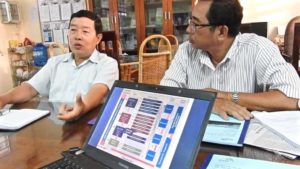
Dr. Duong Van Ni (on left) and Dr. Le Anh Tuan (on right). Scientists researchers and specialists on the Mekong Delta who strongly oppose Hydropower Dams in the Mekong River Basin. This photo was taken during our meeting to discuss the MDS-IAR results at Can Tho University, in Can Tho, Mekong Delta, Vietnam, in February 2016. – Photo by Shanti Cantrelle © Feb. 2016
According to a Cambodian present at the Meetings, the Vietnamese stakeholders joined Oxfam in “trashing” the MDS Study at the Meetings in 2015. This is not surprising.
Scientists at Can Tho University in the Mekong Delta, with whom I discussed the findings of the MDS Study in February 2016, are understandably upset with the Consultants.
They claim they are shocked at the poor quality of the presentation of the results in the MDS document making it difficult to read, also by the fact that important data impacting the Delta is missing, and the study has some wrong interpretations. The Vietnamese scientists are angry that Vietnam payed a lot of money to the consultants but did not get a “high quality study as expected from DHI”.
On saying this, let it be known that Vietnamese scientists strongly and openly oppose Hydropower Dams on the Mekong River, and have been publicizing this for many years!
We agree with the Vietnamese scientists on all points. Unfortunately, because they were so bogged down with hundreds of details of the study, they had failed to notice the main recommendation of the Draft-MDS Study, which I pointed out to them. That was:
“The main recommendation of the DRAFT-MDS Study is to AVOID the construction of Dams in the mainstream of the Mekong River.”
Unfortunately, by the Vietnamese missing such an important recommendation, (because they were so focused on the interpretation of the results of the MDS Study), and by adding their voice to the “Oxfam-led trashing” of the MDS-IAR Study: Vietnam stakeholders unknowingly played into the scheme of the pro-hydropower stakeholders.
As a consequence of Oxfam’s discrediting campaign and surreptitiously directed by Oxfam, the Consultants were ordered to Change the Conclusions and Recommendations in the Final Report of the MDS-Study.
These changes do NOT benefit Vietnam. In fact, the construction of any more dams – whether in the mainstream of the Mekong or in its tributaries, increases the risks for the Delta of further significant: sinking, salinization, channelization and a massive loss of productive lands, aquaculture and resources.
Hence, huge economic losses plus a humanitarian disaster will ensue for Vietnam from any further Dam construction in the Mekong River basin.
The loss of productive land not only implies loss of harvests of rice, fruit, vegetables and fisheries, but most importantly, it will lead to the RELOCATION of millions of poor farmers and fishers whose lands are rendered unusable by salinity and whose homes are threatened by rising sea levels…
What reasons do we have to state that Oxfam Supports Hydropower Development in the Mekong Basin?
Apart from obvious reasons raised above and below, we’ll also address this issue in separate documents: Part 1, Part 2 and Part 3 of an upcoming series of articles in preparation.
COMING SOON: Our assertion that Australian Oxfam & DFAT support Hydropower Development in the Lower Mekong Basin is neither an unfounded conspiracy theory, nor a slandering statement on our part. Rather, it derives from several facts, which we will discuss in three separate documents of an upcoming series entitled:
“Australian Oxfam & DFAT Support Hydropower in the Mekong River“
Part 1 – Evidence that Oxfam Australia Supports Dams. This is a detailed account and examination of my Personal interaction with Oxfam’s Mekong Regional Manager in Cambodia: Ms. Pauline Taylor McKeown (on 28 October 2015), and the revelations derived from it. The Oxfam Manager clearly told me she fully supports Laos efforts to “reduce poverty”, even if that includes building Hydropower Dams (She saw me taking the notes of our conversation, which I will publish in Part 1).
Part 2 – Review of the “Oxfam Analysis on the DRAFT MDS Study” – Ratifies Evidence that Oxfam Supports Hydropower. We examine the objectives, methodology and results of the “Independent Analysis on the MDS Study”, which was commissioned by Oxfam before other stakeholders had a chance to peruse it. We shall refer to this document as the “Oxfam Analysis”, published in November 2015. We will demonstrate that through this Analysis, Oxfam invalidates and thereby discredits the findings of the DRAFT – MDS Study – which recommended that Hydropower dams be avoided in the mainstream of the Lower Mekong River. We show that thanks to Oxfam’s discrediting campaign, the consultants were pressured to CHANGE the results and recommendations originally published in the DRAFT-MDS Study. So that the recommendations in the Final Report of the MDS Study now suggest “a reduced number of Dams” could be built in the mainstream of the Mekong River – as opposed to “avoidance of dams in the mainstream”… Hence, in our review we further confirm our assertion that Oxfam supports Hydropower Development in the Mekong River, and the consequences of its interference putting at risk the Food security, Water Supply, Livelihoods of the poor people of the Mekong..
Part 3 –DFAT’s support of Hydropower Development, Trade Agreements and their implications. Based on openly publicized factsheets in DFAT’s website and economic publications we confirm Australia’s DFAT support for Hydropower Development in the Mekong Region. We examine DFAT’s interest in Hydropower as part of a bigger picture based on Trade Agreements, China’s influence and control in the region, and the devastating ecological, social and economic consequences of such Agreements.
Hence, we will demonstrate that both Oxfam and DFAT support Hydropower Development in SE Asia.
For now, it is proposed that “Oxfam Australia” is aligning with Australia’s DFAT Aid Projects.
And the Australian DFAT clearly publishes its full support for Hydropower development in the Mekong region in its own website:
“Australia’s Mekong Water Resources Program will continue to help develop and better manage the region’s water resources for greater economic opportunities, as well as to protect the 60 million people that rely directly on the Mekong River for their livelihoods (sic). Hydropower development is vital (?) for the economic future of countries of the Mekong Basin, and its transparent management is critical to the stability of countries and regional links. Through targeted investments in quality planning, our program is helping countries of the region build hydropower dams sustainably” (?)
We beg to differ with most of the statements made by Australian Oxfam & DFAT. This will be discussed in more detail in our upcoming papers mentioned above.
Comments on the FINAL REPORT of the MDS-IAR Study
The results of the MDS-IAR Study are many and too complex, and it is not in the scope of this article to examine the findings in detail. This task is being undertaken both by a multi-disciplinary team of Scientists in Vietnam, as well as by the MRC. It will take several months to a year to review the findings properly – rather than the 3 weeks it took the Oxfam team. It has taken us several months sifting through the MDS documents to arrive to general conclusions.
Our aim is to find out what are the main conclusions and recommendations of MDS study, and compare these to the conclusions and recommendations of previous studies. The nitty gritty of the exact numbers relating to sediment transfers, fish numbers or water volumes, or the NPV or GDP involved are not in our scope.
In its Executive Summary, the Final Report MDS-IAR states:
“In conclusion, the proposed mainstream cascade would cause very high adverse impacts to the Mekong River floodplains and Delta due to the combined interaction of dam barrier effects, highly reduced sediment and nutrient loading, and increase in salinity incursion.
Yield of the critically important capture fishery could be reduced by 50%, and up to 10% of fish species in the region could be lost.
The large amounts of sediment trapped behind the dams would greatly decrease the delta’s capacity to replenish itself making it more vulnerable to sea level rise and saline intrusion, and may worsen coastal erosion.
Loss of nutrients trapped along with the sediments will decimate the unmatched productivity of the flood-affected parts of the delta system.
In the Mekong River Delta, the food, health, and economic security of the local populations are inseparably intertwined with the integrity of the natural environment. Un-mitigated mainstream hydropower development in the LMB would cause long-lasting damage to the floodplains and aquatic environment, resulting in significant reduction in the socio-economic status of millions of residents and creating social and economic burdens on local and regional economies. With regard to the Mekong River Delta as a unique system of national and international heritage, the planned hydropower cascade would substantially and permanently alter the productivity of the natural system leading to degradation of all the Delta‟s related values.”
The paragraph of most interest reads:
“Projected impacts on capture fisheries and biodiversity could be reduced, primarily through avoidance, which could include
1) constructing only selected hydropower projects from the planned cascade, and in particular avoiding construction in the lower cascade, and/or 2) relocating some planned projects off the mainstream to tributaries.
Fish passage technologies and/or dam design changes may be considered to mitigate some of the projected losses. However, the effectiveness of fish passage technologies has not been proven in the context of the Mekong Basin and its highly diverse fish community. Therefore, it is uncertain what degree of relief fish passage technologies might be able to provide. Also, it is likely that even the best available fish passage technologies may not be able to handle the massive volume of fish migrations, which during peak migration periods can reach up to 3 million fish per hour, and the diversity of migration strategies that characterise the hundreds of fish species in the basin.”
Along with this MDS Study, we reviewed the literature to ratify its results and to find answers to the following simple questions:
- Is it safe to build a cascade of 11 Hydropower dams in the mainstream of the Lower Mekong River? NO!
- Do the risks posed by these cascade of Dams outweigh the benefits? YES!
- Do the Dams put at risk the Food Security, Water Supply, the Livelihoods, the Health of 60 million people – in Laos, Thailand, Cambodia and Vietnam? YES!
- Do the Dams pose a serious threat to the viability and balance of the Mekong River ecosystem per se? YES!
While taking into account our limitations to give an in-depth review of this study, after reviewing the documents we conclude that the Final report does not make justice to the data collected. That is, the documents are not well written, which is very surprising for a report done by DHI. The documents are difficult to read and interpretation has been in some instances contradictory to the findings.
We concur with Oxfam in the fact that some important data is missing: on salinity incursion and damage to the Delta, impacts on the Tonle Sap Lake. In addition, impacts of the Don Sahong Dam, and dams in the tributaries such as the LS2 Dam are missing, and more.
However, gaps in the data were inevitable in a study as complex as this, with a wide scope of issues, and an ecosystem as complex as the Mekong River, the Tonle Sap lake and its Delta.
Of particular concern to us is however, is that areas of crucial importance to the impacts of the cascade of Hydropower Dams in the Lower Mekong River were not investigated (page 9):
“Note that the IAA (the study area) is located downstream of the southernmost proposed mainstream dam (Sambor); thus, the study did not directly quantify or consider changes or impacts upstream of dams, including effects of the creation of reservoirs.”
We contend that the study area could have been better determined and clearly established by Vietnam and Cambodia, as well as by the sponsors before the study was launched!
If the main concern of both Vietnam and Cambodia was to find out what would be the main impacts on the Tonle Sap system and the Delta, then there was enough previous research that indicated the area of study should have been from the Don Sahong Dam area, and all the way down to the Delta, given that:
- Major damages to fisheries would occur by blocking the main fish passage around the Don Sahong Dam area;
- The construction of 2 mainstream dams the Stung Treng Dam and the Sambor Dam would both block the fish migrations, nutrient and sediment transfers to and from the Tonle Sap system and Delta (not just the latter which was studied); and
- Fish migrations, nutrient and sediment transfers would also be seriously damaged by the blockage of 2 major tributaries to the Mekong River in NE Cambodia by the Lower Sesan 2 Dam.
This huge gap in information is not the fault of the Consultants, but falls squarely on those who commissioned the study (Vietnam and Cambodia) and their sponsors (DFAT/ Oxfam). It is understandable, however, that the larger the study area the larger the cost of the study. Then again, if countries were going to invest in such a study, it should have been better considered. For without a doubt the combined upstream damages in the areas above mentioned will have a significant impact both on the Tonle Sap system and the Delta. The impacts will not just be confined to the Sambor dam.
On saying this we agree with the consultants’ findings that the Sambor Dam will have major impacts.
We recently did a ‘Reconnaissance Journey along the Mekong River’ from Don Sahong Dam area – border of Laos and Cambodia – to the Mekong Delta in Vietnam (January & February 2016). We organized community Meetings at many villages affected by Hydropower Dams – planned and in construction. We gathered a lot of information from scientists, villagers, fishers, farmers, NGOs and the public throughout Cambodia and in the Mekong Delta in Vietnam. So we have a fresh amount of data and observations to back up our comments.
The reason we bring this up, is to inform the readers that this and subsequent articles are not just “desk reviews”, but are also based on field work in Dam related areas, and important ecosystems in the Lower Mekong basin.
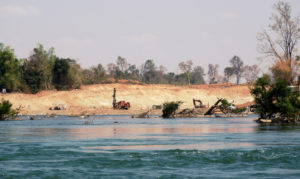
Melong River – Don Sahong Dam construction site. Located in southern Laos on the border with Cambodia – 1.5Km from the township of Preah Rumkel in Cambodia. Photo by Shanti Cantrelle © Feb. 2016
We observed that the Don Sahong Dam had commenced construction when we visited the area on the 1st February 2016.
Hence, the Laos government decided to push ahead and start construction of this the most contested of all dams, emboldened by the support of Oxfam, DFAT, and the Chinese banks.
As I mentioned to Oxfam in a separate letter in December 2015: the Oxfam Analysis created “a window of opportunity” for Laos to go ahead and continue building dams, while the politics and study nit-picking was taking place…
We also visited many sites of Dams planned and in construction in Cambodia in February 2016. This included a visit to Sambor and Koh Phdao, the site for the largest of all Mekong Rivers planned dams – the Sambor Dam. We reiterate the Consultants findings that the Sambor Dam would be the most dangerous of dams to be built in the mainstream of the Mekong River, not only because it will be the largest of all dams to be built in the main channel, but because the ground in which it would be built is extremely unstable, making it a dangerous dam with propensity to breakage. The Sambor Dam would indeed be huge!
According to a Mekong Dolphin Guard, fishermen and other villagers in the Mekong island of Koh Phdao, Chinese Consultants visited the area in two occasions in different years. They had come to collect soil samples from the bottom of the Mekong River in the area planned for the Sambor Dam.
The locals were told by the Chinese consultants that “the soil was very crumbly and not so good to build the foundations for the Sambor Dam, but that they were going to give it time for the soil to settle“(!) The Chinese said that after a few years the soil would be good to use (!).
This information corroborates the findings of the MDS Study, that the soil in the Sambor area is not suitable to build the Sambor Dam, and how dangerous it would be for downstream communities. Particularly concerning is the finding that if the Sambor Dam was to break it would cause an 8 meter high tsunami-like flood wave that will crush the town of Kratie – even though this town is located 35 Km downstream!
We also visited the area of the Tonle Sap system (river and lake), including “Floating villages” – which were not ‘floating’ at the time as the drought had already set in. We mention this to clarify the following issue.
An unknown Cambodian “researcher” recently wrote to insult me for my comments on the ‘Oxfam Analysis’, and to justify the Oxfam Analysis trashing of ALL findings in this Final MDS Report on the grounds that:
“The modelers always say “Garbage in! Garbage out!” that means if you put garbage in, the model will result in garbage also. The maximum error in modelling Tonle Sap is more than 1m which made difference in area of thousands km². If you learned mathematics well, then you can imagine how big is the error and will cause wrong conclusion! All impacts in the study were based on the change of water flow and level.
If there is big error in water levels, how can we correctly conclude the other related impacts?”
Sadly, THIS approach at discrediting ALL the results of this MDS Study is typical of the many comments in the Oxfam Analysis. And indicative of the forcefulness of Cambodian Pro-hydropower stakeholders.
For starters, the MDS Study was not only based on hydrology! In fact, the study on sediments was most important! In addition, for an example of the large range of variation of water levels in the Tonle Sap system, we provide the photo below.
This photo was taken in the “Floating village of Kampong Khleang” in the Tonle Sap Lake of Cambodia, where villagers have been marking the height of water levels since 2001. This photo was taken in February 2016. As can be observed in this photo, there are no markings for 2014 and 2015. When we asked the Village leaders why there were no markings they replied that the water level has been so low in 2014 and 2015, that it had not reached the bottom of the bridge!
Notice also the difference in water levels between 2012 (the marking in the lowest part of the bridge near the ground) and 2013 (towards the top of the bridge wall).
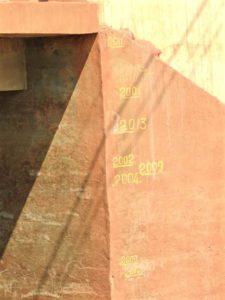
Photo – Bridge in the outskirts of the Floating Village of Kampong Khleang, Tonle Sap Lake, Cambodia. Photo by Shanti Cantrelle © Feb. 2016
In our opinion, the modelling is speculative at the best of times and despite the efforts of the consultants – both for the Mekong River system and the Tonle Sap floodplain, anyway.
This is because there is no way of predicting what the water levels will be because of the great climatic variability we are experiencing at present. This could well become even more extreme in the future…
Hence, the Laos government decided to push ahead and start construction of this the most contested of all dams, emboldened by the support of Oxfam, DFAT, and the Chinese banks.
As I mentioned to Oxfam in a separate letter in December 2015, the Oxfam Analysis created “a window of opportunity” for Laos to go ahead and continue building dams, while the politics and study nit-picking was taking place…
We also visited many sites of Dams planned and in construction in Cambodia in February 2016. This included a visit to Sambor and Koh Phdao, the site for the largest of all Mekong Rivers planned dams – the Sambor Dam. We reiterate the Consultants findings that the Sambor Dam would be the most dangerous of dams to be built in the mainstream of the Mekong River, not only because it will be the largest of all dams to be built in the main channel, but because the ground in which it would be built is extremely unstable, making it a dangerous dam with propensity to breakage. The Sambor Dam would indeed be huge!
On the other hand, the following paragraphs (p.69) show serious impacts to the livelihood of people in Vietnam and Cambodia worth noting:
“Impacts associated with food sources are likely to cause higher and longer effects on livelihoods. In Viet Nam, the nearly 360,000 tonnes of lost fish production, could translate to a decline of 28 kilograms (kg) per fisher – for about 1.2 million fishers, assuming that they would typically take home about 9% of their catch. This level of decline, if applied across all consumers in the region, would translate to a 10 kg decline in fish availability. These losses would require other fish (aquaculture) or other protein sources, which would in turn cause further land use and environmental impacts.
Reductions in food sources in Cambodia would be at a larger degree because their higher level of dependence on fish – at around 47 kg/person. The 42% loss of fish consumption leads the consumption rate down to 21 kg/person. Fishers themselves, who consume an even greater quantity of fish, stand to lose approximately 58 kg per fisher, annually. Other impacts are listed below:
- Income loss would occur for both farmers and fishers. In Viet Nam, farming income could decline by nearly 28% at the highly impacted communes of An Giang and Dong Thap.
- The income loss could affect poor farmers accounted for 7% and 14% in those communes in An Giang and Dong Thap, respectively. The loss of fisher income in Viet Nam could rise to 50% of normal earnings from the fishery.
- In Cambodia, impacts would also disproportionately affect poor rural households. The estimated loss in fishery income could be as high as 47% for an estimated 400,000 households of the country. Among the 2.7 million farmers, incomes could decline by approximately 4%, but impact the provinces of Kandal and Kampong Cham much worse.”
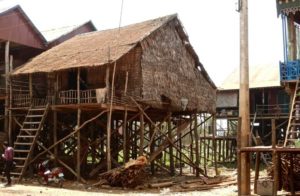
House on stilts – Kampong Klheang ‘Floating Village’ – Tonle Sap Lake, Cambodia.
Photo by Shanti Cantrelle © Feb. 2016
Despite the shortcomings of the Final Report of the MDS-IAR, we consider there is enough data available to conclude and ratify the recommendations by three other very important studies – i.e. the SEA (2010), the Costanza Report (2011) and the EESI of Mekong Hydropower Development (2015) – [see References].
These three major studies concluded that Hydropower Dams would have extremely damaging consequences at environmental, social and economic levels, which outweighed the benefits.
The first two studies agreed that a Moratorium on Dams should be placed on the main stream of the Mekong River.
While the EESI Report suggested that: Countries should PAY Laos $ 300 million over the next 30 years – for loss of ecosystem services. So Laos STOPS building Dams. They claim this is the same amount Laos would get from Hydropower profits in that period.
The DRAFT- MDS Study also urged avoidance of Dams in the mainstream of the Mekong (26 Oct. 2016).
Unfortunately, the Recommendations and Conclusions originally published in the Draft– MDS Study in October 2015, have been tampered with and changed.
Upon reviewing the Final MDS-IAR Report we found that Oxfam was successful at pressing the Consultants to change the wording of the impacts they had previously reported in the Draft-MDS Study.
That is, Oxfam’s Manager got away with imposing her wishes to include the construction of dams, and her most strongly upheld conviction: that “Dam Mitigation measures will alleviate all impacts.” (This will be discussed in Part 1 of our upcoming series of articles).
This is clearly visible in the changes made by the consultants in two sections of the Final Report MDS.
The Executive Summary (pages ES-1 to ES-2) has a new paragraph added, which reads:
“The assessment results indicate that the planned mainstream hydropower cascade (Scenario 1) would cause high to very high adverse effects on some of the key sectors and environmental resources in Cambodia and Viet Nam if implemented without mitigations. Cumulative adverse effects of the planned cascade and tributary dams (Scenario 2) and the planned cascade and proposed water diversion schemes in Thailand and Cambodia (Scenario 3) would pose even greater impacts to the Mekong Delta in comparison to Scenario 1 effects. Under all three scenarios, the most severe adverse impacts are anticipated to result from a combination of the dam barrier effects and the reduction in sediment- associated nutrient loading.
[NEW PARAGRAGH]: Development alternatives on constructing and operating a fewer number of dams would decrease the projected impacts to varying degrees depending upon which of the 11 proposed dams are constructed.
Hence, the content of the Final MDS Report is quite different to the Draft MDS Study pre-Oxfam Analysis and intervention. It read before: “avoidance of Dams in the mainstream”, but it is now changed to “operating a fewer number of dams.”
One could be forgiven for concluding that Oxfam, DFAT and the pro-hydropower lobby groups are pushing their agenda of “some Dams are better than none” in the mainstream of the Mekong…
These changes are further ratified under the section ”Scenario 1. Mainstream Hydropower Cascade”, which now reads in the Final Project Report (2016, p. 10):
“This scenario was used to determine the overall effects of 11 planned LMB mainstream hydropower projects operating simultaneously. The design characteristics of each proposed dam was based on information contained in the MRC‟s BDP2 Report (MRC 2011). To ensure that all potential effects of the mainstream dams were identified and assessed, no mitigation measures, such as sediment management and fish passage facilities, were included in the design.
[NEW PARAGRAGH}: Thus, the impacts identified by the analysis of this scenario could be lower if fewer dams are constructed or if customized, site-specific mitigation measures are incorporated into the design of the mainstream dams.”
This sadly goes to show that the results of studies do get “tampered with and changed by Sponsors” to satisfy their agendas…
We reiterate that a scientific study is aimed at gathering information and presenting results based on the information collected at the time of the study. The results of a scientific study are not meant to be shared around, collect opinions and incorporate comments of different parties, thereby CHANGING THE RESULTS!
Yet Oxfam did just that – both with the Oxfam Analysis and with the Final Report of the MDS Study! This is the problem of having bureaucrats making decisions that affect the welbeing of 60 million people!
This leads us to conclude that extremely important DECISIONS BEING TAKEN in the MEKONG REGION are being based on FALSE premises, rather than on “scientific truths”. That is, decisions have been made based on the twisted results of some studies that have been TAMPERED WITH and CHANGED to suit the AGENDAS of stakeholders!
Unfortunately, such agendas are NOT considering the well being of people and environment, but rather PROTECTING the INTERESTS of: the Hydropower industry, Trade Agreements and Banks!
This is unethical and dishonorable!
Particularly, because “the development of alternatives of Dam construction” proposed are “fish ladders” and “sediment release technologies and techniques”, which Oxfam so strongly advocates.
Fish ladders have been proven to be inefficient (Pelicice et al, 2012; Noonan et al, 2012; Martins da Silva et al, 2012 – See references). And the sediment release techniques and technologies have never been tested in the Mekong system and cannot be guaranteed to work (Baran et al., 2015; Kondolf, et al., 2015; Kondolf et al., 2014b).
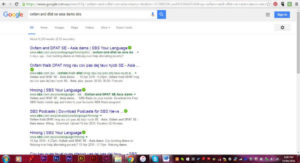
Screenshot – Cache SBS Radio Podcast Dr. Corredor – 10 April 2016. We show this screenshot as proof that the Podcast was put on air, but was pulled out by the SBS Management, presumably under pressure from Oxfam in Australia.
Evidence that Oxfam Australia was at the forefront of the push to make the above changes in the Final Report of the MDS Study, is provided by the Oxfam Manager in Cambodia who wrote the following email to SBS radio – in response to my Radio interview in which I decried Oxfam & DFAT’s support for Hydropower in the Mekong basin.
We show this screenshot as proof of the SBS Radio Podcast by Dr. Corredor – 10 April 2016. This Podcast was put on air, but was pulled out 5 days later by the SBS Management, presumably under pressure from Oxfam in Australia?
In that Podcast, I exposed Oxfam’s support of Hydropower Development in the Mekong River and held it accountable for putting at risk the food security of 60 million people, rather than calling on a Moratorium on Dams.
Below is the Full text of the email sent by Oxfam to SBS:
From: Pauline Taylor McKeown []
Sent: Friday, 8 April 2016 11:22 AM
To:XXX
(SBS Radio)
Subject: Interview
“Dear XXX, Thanks for the interview and sorry that the line was poor. I wanted to clarify the point I tried to explain about the MDS report as this appears to be where there is a misunderstanding with Dr Lilliana.
The MDS study was commissioned by the Vietnamese Government and a draft made available in October 2015
Community groups we work with were concerned that there were significant gaps in the study around the proposed dams on sedimentation, fisheries, biodiversity and people’s livelihoods particularly in Cambodia
“Oxfam commissioned an independent analysis due to these concerns.”
[ED]: As previously mentioned, this is NOT TRUE as nobody other than key agencies had access to the DRAFT-MDS Study at the time.]
The independent analysis was shared with community groups and discretely with the National River Committees of both Cambodia and Vietnam (who share the delta)
The MDS report was finalized December 2015 and made available January 2016. Some of the concerns raised in the (Oxfam) ‘analysis’ have been addressed in the final report. (!!!) Oxfam has made it clear that we still believe some impacts are underestimated particularly in Cambodia and the Tonle Sap lake which is a critical fish breeding ground (nutrition and livelihood) for the whole region. We will continue to raise the findings of the MDS study and our analysis at every available opportunity to ensure all stakeholders understand what the study says on the potential impacts in the region.
One opportunity will be when the Mekong River Commission reviews the MDS study in its own MRC Council study.
Trust this helps to clarify. Best Wishes, Pauline
PAULINE TAYLOR McKEOWN | Mekong Regional Water Governance Program Manager Oxfam
#94. Russian Boulevard, Sangkat Teuk Laak 1, Khan Toul Kork, Phnom Penh. Cambodia.
Tel: +855 (0) 23885424 | Fax: +855 23 885452 | Mob: +855 (0)92 667 538
Skype: pauline.taylor.mckeown
www.oxfam.org.au
In her email, the Oxfam Manager ‘shoots herself in the foot’ – by candidly admitting that the concerns raised in the Oxfam Analysis have been addressed in the final report – with the changes going from “avoidance of dams” to “construction of fewer dams with mitigation measures”!
The Oxfam Manager has no shame about tampering with the results of studies, but instead is proud of such an “achievement”… This is outrageous!
It is ironic that Oxfam’s manager tries to give the impression that Oxfam cares so much about the “impacts of Dams”. Further evidence that Oxfam Australia does not really believe that Dams will result in significant impacts, and that Oxfam supports Hydropower development in the Mekong Basin is provided by the following facts:
Although Oxfam commissioned the “EESI Report”, it REFUSED to CHAMPION this study, or to even mention it in the “Oxfam Analysis“. Despite the fact that the EESI Report was published before the Oxfam Analysis was completed, and despite the fact it would provide support to the MDS Study findings.
The very significant conclusions are noted below (EESI Report, Nov. 2015, page 11):
“8. CONCLUSIONS AND RECOMMENDATIONS
8.1. This study confirms the Costanza report assessment that, by changing some key assumptions in BDP2 (low discount rates for natural resources; fish value of $ 3/kg), the conclusions in BDP2 would be completely changed; the economic feasibility of the planned hydropower projects would change from positive (as in BDP2) to negative in terms of NPV.
8.2. The revised case in this study shows that the economic impact of the forecast loss of capture fisheries (based on migratory fish) is much larger than the hydropower benefit.
8.3. Assuming a split of 30% hydropower benefits for the host country and 70% for the country funding the project and importing the electricity, Thailand and Lao PDR are the beneficiaries of the proposed hydropower projects whereas Cambodia and Vietnam would bear the main cost. It is also clear that project developers and electricity importers would benefit but poor, rural fishing communities would suffer.
8.4. This study indicates that the capture fisheries NPV values in BDP2 are understated (loss in tons/year too low; fish value too low) and the hydropower benefit NPV values in BDP2 are overstated (capital investment too low; host country electricity trading benefit too high).
8.5. The economic impact of social/cultural issues are not accounted for in BDP2 but could result in mitigation costs of 5-12% capital investment which would adversely affect project viability.
8.6. If the mainstream projects are not pursued, there would be minimal risk for electricity security in the LMB countries and the forecast electricity demand could be supplied by alternative energy sources (e.g. solar, wind, biomass) and improved efficiency of energy use.
8.7. In the revised case, Lao PDR would have a positive NPV in both scenarios. It is proposed that Thailand, Cambodia and Vietnam should each make annual payments of about $100 million/year (total of $ 300 million/year) to Lao PDR for the next 30 years to compensate Lao PDR for not proceeding with mainstream hydropower development. This proposed payment scheme would be less than the forecast loss of capture fisheries in Cambodia and Vietnam. In addition, the international community could support all needed research activities to develop viable and acceptable mitigation measures during this period.
The following recommendations are proposed for further consideration:
- Consider implementing a “payment for ecosystem services” to Lao PDR from other countries in the LMB as well as elsewhere.
- Comprehensive risk assessment by requiring dam developers to post a recoverable assurance bond large enough to cover worse case damages.
- A requirement that all hydropower development projects include the full cost and benefit of social and environmental conservation mitigation measures. Subsequently, the negotiated power purchase costs will reflect the true costs of hydropower development.
Oxfam, however, failed to mention, let alone promote the important conclusions and most important conclusions and recommendation offered in the EESI Report regarding ‘Payment to Laos for Ecosystem.
Oxfam’s mission to reduce poverty should have included lobbying all LMB governments, other countries and international oragnizations to:
‘Pay Laos for Ecosystem Services’ – i.e. compensate Lao PDR for not proceeding with mainstream hydropower development.”We contend that Oxfam’s failure to take any ‘public’ action to prevent the construction of Dams, and its refusal to promote studies or organizations (such as ours) that oppose Dams in the Mekong Basin is further evidence of Oxfam’s support of Hydropower Development in the Mekong. In addition to the fact that Oxfam does NOT support or champion studies or villages that OPPOSE the construction of Hydropower dams in the Mekong basin! (more on this in Part 2 of upcoming series.)
For if Oxfam Australia’s aim was truly to “inform stakeholders of the impacts of Hydropower Dams”, then Oxfam should have notified all stakeholders of the conclusions of the EESI Report it had commissioned, as well as, promoted the recommendation above.
Yet, all Oxfam Australia did was discredit the MDS Study with zeal and vehemence, which it should have used to promote the EESI Report instead! This in turn, would have ADDED VALIDITY to the findings of the MDS Study.
Oxfam cannot possibly use the excuse that it was not aware of the EESI Report’s publication. Oxfam has clearly demonstrated that it keeps a close eye on any studies it funds! This is demonstrated by its readiness to undertake the Oxfam Analysis before it was officially released!
We remind the reader that this same Oxfam Manager was responsible for creating the “Oxfam Analysis”. She masterminded, funded, organised, managed and promoted the analysis, as well as the campaign to discredit the findings of this Final Report of the MDS-IAR study.
Finally, it is important to mention the results of the latest study – specifically on sediment starvation caused by the cascade of hydropower dams to the Mekong River, which Oxfam also failed to mention by Kondolf et al. (2015):
“The Mekong River is undergoing rapid dam construction. Seven mainstream dams are completed or under construction in China and 133 completed or proposed for the Lower Mekong River basin.
Results indicate that the 133 dams built as planned would trap 96 % of the river’s former sediment supply to the delta…
The most significant downstream impacts of this sediment-starved water will be accelerated erosion and subsidence of the delta in response to the virtual elimination of its sediment supply. Upstream, the mostly bedrock channel upstream of Kratie will have its thin sediment deposits stripped away (with consequences for aquatic organism’s dependent on the alluvium) and the bedrock reach of Vientiane will likely incise.”
We’d like to point out that this study was counting the effects of only 133 dams for the rest of the Lower Mekong Basin. However, the equation has now dramatically changed to: 350 dams by Laos and 14 Dams by Cambodia.
That is a total of 364 Dams … nearly 3 times the amount of dams studied.
We could easily extrapolate that if 133 dams would have starved the delta of all sediments, there is little hope for it, if triple that amount of Dams are built!
This poses a very real and tangible THREAT to the land, subsistence
and livelihoods of 20 million people in the Mekong Delta of Vietnam!
Conclusions
In all fairness, and despite some shortcomings, we believe the MDS-IAR Study offers enough valid and valuable information to support the notion that Hydropower Development in the Mekong River Basin (both in the mainstream and the main tributaries) should not be build! Any gaps in data can be solved through other subsequent studies.
We now understand it was necessary for Oxfam to surreptitiously discredit the findings of the Draft – MDS Study, to get support from other factions, agencies and stakeholders at the Workshop it convened, and at the CNMC and VNMC Meetings – in order to justify making the CHANGES to the FINAL Report of the MDS-IAR.
Oxfam Australia was the principal actor in ensuring that the previous recommendation of AVOIDANCE OF DAMS got replaced with FEWER DAMS and Mitigation measures.

Khmer Child – Kampong Phluk, Floating Village – Tonle Sap Lake, Cambodia. Photo by Shanti Cantrelle © Feb. 2016
This is definitely not something for Oxfam to be proud about!
As by doing so, Oxfam Australia is effectively putting at RISK the Food security, Water supply, and Livelihoods of 60 million poor people. As well as, jeopardizing the viability of the Mekong River, the Tonle Sap system and the Mekong Delta.
Indeed, Oxfam Australia’s ‘unethical conduct’ and ‘poor social and environmental consciousness’, could indeed result in a costly humanitarian crisis…
Oxfam Australia is not-aligned to its purpose and mission of helping reduce poverty.
Helping protect the food sources of poor people in developing countries is a means to reduce poverty. Instead, Oxfam is aligning with the Hydropower groups, thereby helping Laos become richer at the expense of 60 million poor people. This is shameful!
———-
By promoting the above changes to the Final Report and discrediting its findings, Oxfam is effectively protecting the vested interests of the Hydropower industry in SE Asia, rather than protecting the Food security, Water supply, Livelihoods and wellbeing of 60 million local people – which happens to be Oxfam’s original, and apparently ‘forgotten’ brief.
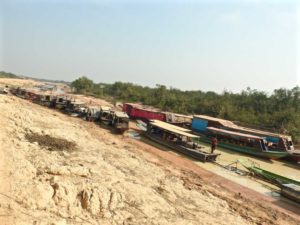
Photo- Tonle Sap River-Kampong Phluk – Boats at entrance of village. Photo by Shanti Cantrelle © Feb. 2016
This is important. Because, while the different Lower Mekong countries, the Mekong River Commission, the local scientists, the NGOs and Oxfam continue the same process used for the past decade of getting bogged down in greedy politics and nit-picking at studies – Laos keeps building Dams, thus threatening the viability of the Mekong Ecosystem and the welfare of downstream communities who depend on this river for their food and water supply!
In fact, by the Oxfam Analysis discrediting the MDS Study, rather than promoting a Moratorium on dams, it actually encouraged both Cambodia and Laos to build more dams!
As a result, and emboldened by the support of Oxfam, China and lastly by Cambodia, Laos took advantage of the confusion generated by studies and politics, and started the construction of the Don Sahong Dam, against the wishes of Vietnam. Thus, Laos is happily building Dams illegally, and totally unconcerned about the impacts to downstream countries.
Unfortunately, Laos recently announced it is building 350 Dams nationwide, and Cambodia will be building 14 dams.
NOTE: Laos is at this moment preparing to start construction of a third Hydropower Dam on the mainstream of the Mekong River: the Pak Beng Dam! This Dam is the worse in terms of sediment retention. In that it blocks the highest Sediment Bedload of all dams at 18 Mt/year deposited (Summary, MDS 2016, p. 27).
Hence, lower amount of sediments equals less nutrients, which in turn, means less fish supply for Local riverine communities, who depend on fish for their nutrition and livelihood! This is definitely not a dam to be allowed!
An overall of 364 NEW Dams pretty much guarantees the destruction of the Mekong Ecosystem and its resources over a short period of time.
If 133 dams would have starved the delta of all sediments,
there is little hope for it, if 364 Dams are built!
Hence, the reality of the THREAT to the very existence
of 20 million people in the Mekong Delta hangs in the balance.
It now depends on the good will of the rest of the world
to avoid a Humanitarian & Ecological Disaster: The ECOCIDE of the Mekong!
It now depends on the good will of the rest of the world to avoid a Humanitarian and Ecological Disaster: The ECOCIDE of the Mekong!
That Oxfam Australia has a direct input in promoting a potential Humanitarian and Environmental disaster ensuing from these dams – if allowed to be built – is inexcusable!
CALL FOR ACTION
We call for an International Agreement by Japan, USA and the European Union to help avert a Humanitarian Crisis in SE Asia.
We call for an International effort to Pay Compensation to Laos and Cambodia for ‘Ecosystem Services’ – as an incentive to STOP any further construction of Hydropower Dams in the mainstream of the Mekong River.
This will help reduce in part the Hegemony of China in SE Asia.
Otherwise, drastic and irreversible damages will occur to the Mekong River, its fisheries, the Tonle Sap system and the Delta. These in turn, will result in the Loss of Food & Water Supply, Loss of Land, and Loss of Livelihoods for 60 million poor people in Laos, Thailand, Cambodia & Vietnam.
Where will the millions displaced by the Delta’s sinking and eroded river banks be relocated to?
Climate Change will only compound an already severe drought from the North of Thailand to the Mekong Delta in Vietnam!
____________________
References:
Oxfam-Analysis Report of the Mekong Delta Study (MDS IAR)- OXFAM- Nov28 2015_ver1– Prepared for Oxfam Mekong Regional Program, by Dr. Sokhem Pech, Chheng Phen, & Tes Sopharith, Version 1, Nov 28, 2015.
Cambodia PM stands by hydropower, dismisses critics as ‘extremists’ | Reuters – 23 December 2015
Laos Announces Hydropower Push at International Conference – Voice of America – 9 March 2016
ICEM (2010). Strategic Environmental Assessment of Hydropower on the Mekong Mainstream – Summary of the Final Report. Prepared for the Mekong River Commission by ICEM, Hanoi, Vietnam. Also known as “SEA (2010)”
http://icem.com.au/portfolio-items/sea-of-hydropower-on-the-mekong-mainstream-summary-of-the-final-report/
Ida Kubiszewski, Robert Costanza, Peter Paquet & Shpresa Halim (2012). Hydropower Development in the Lower Mekong Basin – Alternative Approaches to deal with uncertainty. Reg Environ Change (2013) 13:3–15, Springer-Verlag 2012
https://www.academia.edu/3174505/Hydropower_development_in_the_lower_Mekong_basin_alternative_approaches_to_deal_with_uncertainty
Costanza, R. et al. (2011). Alternative Planning Approaches for Water Resources Development in the Lower Mekong Basin – Portland State University, Oregon and Mae Fah Luang University, Chiang Rai – Also known as the ‘Costanza Report’
https://www.academia.edu/2960346/Planning_approaches_for_water_resources_development_in_the_lower_Mekong_basin
MRC (2011). Mekong River Commission Assessment of Basin-wide Development Scenarios – Basin Development Plan Programme, Phase 2 (BDP2) – November 2011. – Also known as the “MRC (BDP2)”.
In: Intralawan, A., D. Wood & R. Frankel (2015) – EESI Report
Dugan, P., et al. (2010). Fish Migration, Dams, and Loss of Ecosystem Services in the Mekong Basin. AMBIO 39: 344-348.
Hall, D. and L. Bouapao (2010). Social Impact Monitoring and Vulnerability Assessment: Regional Report. Mekong River Commission, Vientiane, Lao PDR: 179 p.
Intralawan,A., D. Wood & R. Frankel (2015). Working Paper on Economic, Environmental and Social Impacts of Hydropower Development in the Lower Mekong Basin. Natural Resources and Environmental Management Research and Training Center, Mae Fah Luang University, Chiang Rai, Thailand, 15pp
– Also known as the “EESI Report (2015)”
http://www.mfu.ac.th/nremc/content_detail.php?id=298
Pelicice, F.M. & C.S., Agostinho (2012). Deficient downstream passage through fish ladders: the case of Peixe Angical Dam, Tocantins River, Brazil. Neotrop. ichthyol. vol.10 no.4 – Porto Alegre Oct. 2012
http://dx.doi.org/10.1590/S1679-62252012000400003
http://www.scielo.br/scielo.php?script=sci_arttext&pid=S1679-62252012000400003&lng=en&nrm=iso&tlng=en
M.J. Noonan, J.W.A. Grant & C.D. Jackson (2012). A quantitative assessment of fish passage efficiency. Fish and Fisheries (Impact Factor: 8.26). 12/2012; 13(4).
DOI: 10.1111/j.1467-2979.2011.00445.x
https://www.researchgate.net/publication/262951688_A_Quantitative_Assessment_of_Fish_Passage_Efficiency
Martins da Silva, L.G. et al. (2012), Fish passage post-construction issues: analysis of distribution, attraction and passage efficiency metrics at the Baguari Dam fish ladder to approach the problem. Neotrop. ichthyol. vol.10 no.4 – Porto Alegre Oct. 2012
http://dx.doi.org/10.1590/S1679-62252012000400008
http://www.scielo.br/scielo.php?script=sci_arttext&pid=S167962252012000400008&lng=en&nrm=iso&tlng=en
Baran E., Guerin E. & Nasielski J. (2015). Fish, sediment and dams in the Mekong – How hydropower development affects water productivity and food supply. Penang, Malaysia: WorldFish, and CGIAR Research Program on Water, Land and Ecosystems (WLE). 108 pp.
http://pubs.iclarm.net/resource_centre/Fish-sediment-and-dams-in-the-mekong.pdf
Kondolf, G., Z. Rubin & J. Minear (2014b). Dams on the Mekong: cumulative sediment starvation. Water Resources Research 50(6): 5158-5169.
http://onlinelibrary.wiley.com/doi/10.1002/2013WR014651/abstract
Kondolf, G.M., G. Annandale & Z. Rubin (2015). Sediment Starvation From Dams In The Lower Mekong River Basin: Magnitude Of The Effect And Potential Mitigation Opportunities. E-proceedings of the 36th IAHR World Congress, 28 June – 3 July, 2015, The Hague, the Netherlands
http://89.31.100.18/~iahrpapers/88661.pdf
Study on the Impacts of Mainstream Hydropower on the Mekong River – Draft Impact Assessment Report – Impact Assessment Methods and Results – Summary Version. Also known as the Mekong Delta Study (MDS) – Report prepared for the Ministry of Natural Resources and Environment, Vietnam (VNMC) by DHI & HDR – 10 October 2015.
In: Comments on: Draft – Study on the Impacts of Mainstream Hydropower Dams on the Mekong River (MDS), Impact Assessment Report – L. Corredor on behalf of Scientists for the Mekong – December 17, 2015.
https://www.scientists4mekong.com/comments-iar-draft-impacts-of-hydropower-on-mekong-river/
MPE-MEKONG EIA BRIEFING: Environmental Impact Assessment Comparative Analysis In Lower Mekong Countries. Baird, M & R.Frankel (2015)
http://www.pactworld.org/sites/default/files/local-updates-files/MPE_Mekong_EIA_Briefing_Final.pdf

